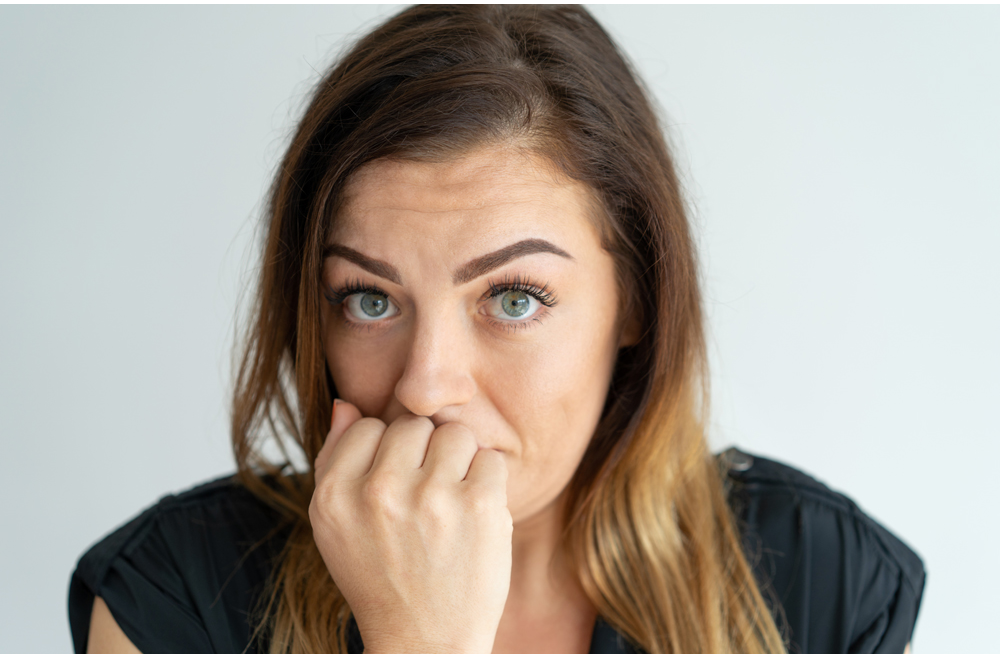anxiety

Anxiety may be a normal temporary reaction to some life situations. However, a chronic anxiety that persists and worsens is a real disease that may interfere with daily life activities. This type of anxiety makes one feel tensed, nervous, frightened for no apparent reason, and may be accompanied with headaches, insomnia and heart palpitations.
Anxiety is an emotional disorder that manifests itself in a feeling of insecurity. Anxiety is characterized by a feeling of apprehension, tension, uneasiness, and terror in the face of an unspecified peril. The patient under the terms of nervousness or worry often expresses it. Anxiety must be distinguished from fear that responds to a real threatening situation. Differentiate panic disorder (corresponding to acute anxiety attacks occurring periodically) and permanent anxiety (generalized anxiety disorder or anxiety neurosis), which affects the subjects in a lasting way.
Anxiety disorders are common, affecting about 2 to 8 % of the adult population each year and are more common among women. The average age of onset of symptoms is between 20 and 30 years.
Anxiety is a normal sensation. It is present in all human beings. Depending on the circumstances, it may take different forms, from simple anxiety-to-anxiety and even terror. Sometimes it manifests abnormally and becomes a disease in its own right. Phobias, panic, obsessive-compulsive disorders, we must recognize the various forms of pathological anxiety.
TYPES OF ANXIETY
There are several forms of anxiety disorders. It is not uncommon for several forms to coexist in the same individual.
Generalized anxiety
In people who suffer from generalized anxiety, anxiety is diffuse and manifested by an exaggerated anxiety about the slightest event of everyday life. People who suffer from it always fear the coming of a catastrophe. Unable to relax, they have trouble falling asleep and often wake up at night. Even if the person realizes that his worries are exaggerated, he is unable to reason. Generalized anxiety is diagnosed when these symptoms last longer than six months. This type of anxiety often begins during childhood or adolescence, but it can also manifest in adulthood.
Simple phobia
Simple phobia, or specific phobia, manifests itself through unreasoned fear of a particular thing or situation. The most common are fear of an animal (dog, mouse, spider, snake), fear of heights, fear of blood, fear of the plane, fear of germs, fear of water, Fear of tunnels and fear of lifts. Simple phobia appears suddenly, mostly in adolescence or early adulthood.
Panic Disorder
Panic disorder is characterized by the occurrence of anxiety attacks or acute anguish attacks. By definition, to talk about panic disorder, the patient has to make at least four panic attacks in four weeks (or at least one if followed by persistent fear of a new attack). These panic attacks are unpredictable and not triggered by particular situations (trac) or organic factors.
Obsessive-compulsive disorder
Obsessive-compulsive people are constantly invaded by ideas or thoughts that cause a great sense of anxiety. The most common subjects of obsession are the fear of being contaminated by germs, doubt, order, perfection and fear of violent behavior. A person may be obsessive, compulsive, or obsessive compulsive. In the long run, obsessions and compulsions can become so invasive that the person who suffers from them has no more time to devote to anything else. The disorder usually occurs during adolescence until mid-thirties.
Post-Traumatic Stress Disorder
Some events may have serious psychological after-effects long after they have occurred. Post-traumatic stress disorder occurs when a person has experienced or witnessed an event in which his life or the life of another person was endangered, Be seriously injured. The person constantly recovers the event with the same feelings of horror and distress. If she is confronted with something reminding her of the event, she reacts strongly.
CAUSES AND RISK FACTORS
Anxiety is sometimes of organic origin and some diseases can trigger it, such as heart or respiratory insufficiency, myocardial infarction or malfunctioning of the thyroid gland (hyperthyroidism). The abuse of certain drugs and drugs can also cause symptoms of anxiety. Finally, anxiety can be the symptom of a nervous breakdown, certain psychoses and most neuroses. Some theories have associated it with sexual dissatisfaction, others with the fear of losing something we love. Nowadays, specialists believe that anxiety disorders come from a combination of factors, both biochemica.
Social and cultural
Anxiety is always present in the neurotic states and is even the constituent element of the neurosis of anxiety.
In hysterical neurosis, anxiety is converted into physical symptoms without organic support.
• But this conversion is often incomplete and some anxiety persists in general.
• In hypochondriac neurosis anxiety attaches itself to the body. These structured symptoms reduce the feeling of anxiety.
• In phobic neurosis, anxiety is fixed on specific situations (crowd, closed space or very widely open, animals), and anxiety manifests itself only in these situations and disappears at the same time.
• In the obsessive neurosis finally, the subject struggles against the thoughts that invade it and anxiety is always present.
SYMPTOMS AND SIGNS
• NERVOUSNESS
• TENSION
• INSOMNIA
Generalized anxiety manifests itself physically through tremors, great muscular tension, Headache (tension headaches) and irritability. It is often accompanied by a feeling of choking, nausea and various physical reactions, such as abundant sweating, an accelerated pulse, or a constant urge to urinate or saddle. It can lead to chronic fatigue, difficulty concentrating and sometimes leads to depression. The person feels abruptly weak. Her pulse accelerates, she feels tingling or numbness in her hands and she is seized with tremors. She may have heart palpitations, chest pains and difficulty breathing. To these symptoms are added fear of a heart attack, fear of losing control and sometimes even fear of dying. The crisis usually lasts a few minutes but sometimes persists for more than an hour. Post-traumatic stress disorder is accompanied by insomnia, irritability and hyperactivity. People who are suffering from it try to avoid the opportunities or people they might associate with the event.
HEALTH RECOMMENDATIONS
Prevention
If anxiety arises mainly from a situational problem over which there is some control, prevent it by changing certain lifestyle habits. A healthy lifestyle can reduce anxiety to a tolerable level. The elements of a healthy lifestyle include:
• A good balance between work, rest and leisure.
• Low intake of caffeine, alcohol, nicotine.
• Good nutrition.
• And most importantly, regular exercise.
When anxiety is linked to individual biological and psychological factors, prevention is much more problematic. A good hygiene of life can only promote the recovery of the person.
Diet
Vitamin, mineral, amino acid or essential fatty acid deficiencies may be involved in anxiety disorders. A healthy and balanced diet will provide the body with all the essential nutrients it requires for maintaining optimal health. Obviously, one should try to avoid stimulants such as caffeine, sugars, sodas or refined foods that are nutrient-depleted and alcohol that reduces the availability of nutrients. The diet should include, among others, whole grain products that are naturally rich in B vitamins and cold water fish or flaxseed oil that are rich sources of omega-3 fatty acids. Hypoglycemia may also induce stress symptoms or anxiety. It is strongly recommended to have several smaller meals providing proteins (from meat, poultry, legumes, dairy products, nuts and seeds) instead of the traditional three big meals of the day. This way, blood sugar fluctuations are better avoided.
Stress management
Every relaxation technique should be considered as a complement to the treatment of anxiety disorders. Whether choosing yoga, meditation, controlled breathing or visualization, find the technique that best suits you to better manage stress on a daily basis.



Comments
Leave your comment